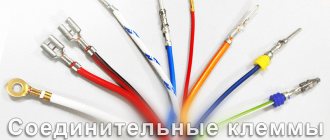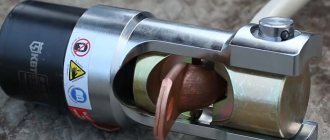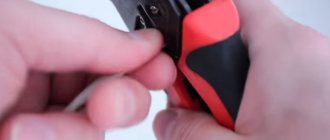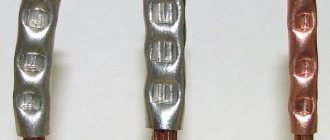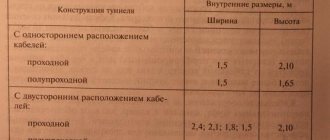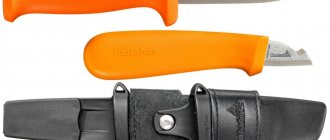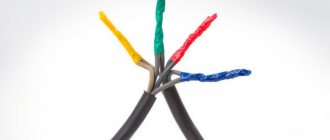There are many ways to connect wires - from the old-fashioned twisting to the most modern self-clamping terminal blocks. But none of them is ideal; each method has its own advantages and disadvantages. In some cases, it is enough to connect the wires in the terminal block; sometimes welding or soldering will be necessary. But there are times when crimping the wires is the best option; we’ll talk about it in more detail.
What is the essence of the method?
Crimping is a method of connecting wires using special sleeves. Outwardly, they look like ordinary tubes and serve as a connecting mechanism.
The wire strands that are to be connected are inserted into the tube from two opposite ends, crimped with press pliers, and as a result, a strong and reliable electrical unit is obtained. The tube is compressed in two or three places, depending on its length and the cross-section of the switched conductors. The connected cores and the sleeve are jointly subjected to deformation. At this moment, the tube compresses and squeezes the conductive surfaces of the conductors. Due to this, the wires interlock with each other, which provides reliable electrical contact.
The junction is then isolated.
Most often, this method is used in situations where it is not possible to use another type of connection. For example, welding requires the presence of electricity so that the welding machine can be connected. When working in a small junction box, it is inconvenient to position the bolt connection, nut clamp or terminal block. And reaching up to the distribution box from the ceiling with a soldering iron is also not very convenient. It is in such cases that crimping wires using sleeves helps out.
The crimping method is most in demand:
- if it is necessary to connect wires in power lines with a high current load;
- for switching multi-core conductors;
- if it is necessary to connect large cross-section wires.
Trouble-shooting
The table shows some malfunctions and how to resolve them:
| Fault name | Cause | Remedy |
| The cable lug press does not apply maximum pressure or does not pump at all. | There is no oil in the piston sleeve, or it is of the wrong consistency. |
|
| Oil is leaking from under the working piston. | The sealing cuff is defective. |
|
A high-quality and convenient tool for crimping cable lugs is the key to reliable connection of cables and wires of any cross-section.
Advantages and disadvantages
There are many positive aspects to crimping:
- The tool used to make this connection is hand-held and does not require electricity to operate. In cases where you have to work in a room where there is no voltage, crimping is the only high-quality connection method.
- Using crimping tubes, you can connect conductors from different metals, which is a solution to the eternal problem of switching copper and aluminum conductors in one electrical unit.
- If welding requires a specialist capable of performing welding work, and when soldering it is necessary to be able to use a soldering iron, then anyone can do crimping; you just need to try the press pliers in action once.
- Using a special crimping tool, it is possible to make connections in any, even limited spaces. It is especially convenient when connecting wires in a socket box or box.
- Crimping with press pliers and sleeves allows you to shorten the connected sections of wires to a minimum.
- Due to mechanical force, the most durable contact connection is created.
- As a result of crimping, a permanent connection is obtained that can withstand heavy physical stress when breaking.
- Installation speed is minimal, connection quality is maximum.
- This contact does not require any maintenance.
The one-piece type of crimping is in some way a disadvantage, that is, if necessary, it is impossible to unscrew the connection and replace one of the conductors. The sleeve can only be cut out.
Instead of an epilogue
Based on the analysis of the market for the instruments under consideration, it was established that almost all of its niches are occupied by models from a foreign manufacturer. If in the budget segment you can still find Russian samples, with fairly good characteristics and at a normal price, then at higher levels they simply do not exist. At the same time, it is worth noting that the entire premium segment is completely “occupied” by samples from the German company. This brand has existed since 1885 and it is not surprising that it managed to completely capture the top positions. However, the price of Knipex tools is very “biting” - it is simply impossible to find their crimper-type device specifically for tips with a price of less than 10,000 rubles. However, if such a crimper was nevertheless found, then it is essentially a banal fake.
Tools and materials
To work, you will need manual (or mechanical) press pliers. They crimp a sleeve with conductors with a cross section of up to 120 mm2. For conductors with a larger cross-section, a press is required, which is driven by a hydraulic drive.
There are pliers with dies for different sections and with adjustment of the punches. A very convenient tool in the sense that you don’t have to constantly reset it to other sizes, just turn the punch screw or matrix to the desired section.
When working with aluminum wires, you will need a special quartz-vaseline paste, which removes the oxide film on the wires and prevents its reappearance.
Copper conductors do not need such treatment, but it is still advisable to lubricate them with ordinary technical petroleum jelly to reduce friction. During deformation, the cores can be damaged, and lubricant minimizes this risk.
Difficulty of choice
In order to correctly select pliers for crimping lugs or special crimpers for connecting cables of SCS systems, you need to pay attention to the following tips:
- Selecting a device begins with a clear definition of the tasks for which it will be used. It is from this generated list that it is necessary to select both the functionality and dimensions of the press jaws. If you have to do not one-time, but permanent work, then universal equipment will be the best choice.
- Not the last criterion will be the price, on which the performance of the equipment will depend. Naturally, world-famous brands are considered a guarantee of quality. If the cost of the device is low, then it is unlikely that you will have to count on its long service life.
- At the time of purchase, the device must be checked for defects, and at the same time, the overall build quality of the structure must be assessed. First of all, you need to pay attention to the presence of all kinds of dents and chips, and also check the accuracy of the contact of the jaws and the position of the handles.
- Special attention must be paid to the shape of the handles. If they have special recesses, they will help to hold the device more securely in your hands.
- Also, it won’t hurt to simply hold the device in your hand - all possible inconveniences associated with weight or shape will immediately appear.
Types of sleeves
It is very important to choose the right sleeves for crimping wires.
According to the material of execution
A copper cable or wire should be crimped with copper sleeves accordingly. They come in two types and have the following abbreviation:
- GM - copper sleeves. They are made purely of copper, do not have any coating or processing, and in appearance they look like ordinary pieces of copper pipes.
- GML – tinned copper sleeves. They undergo a tinning procedure, that is, their surface is treated with a special tin-bismuth layer. This is done in order to prevent oxidation and corrosion processes. It is also known from school physics lessons that copper, like any other metal, oxidizes. Tinning prevents this process; the crimped wires will not enter into a chemical reaction with the tinned sleeve.
I would like to give one useful piece of advice. Do not listen if suddenly one of the experienced electricians tries to prove to you that using GML sleeves it is possible to crimp aluminum wires, since the tin layer will not allow direct contact of aluminum with copper. This is incorrect, because during crimping the surface layer of the tube is deformed and the corrosion process is still inevitable.
To connect aluminum wires, they use products made of the same metal; they are designated GA (aluminum sleeve).
There are also combined sleeves, they are designated GAM (aluminum-copper sleeve), in everyday life many call them aluminum-copper. This option is used when you need to connect wires made of different metals end to end. The sleeve is a tube of two parts; at the junction of dissimilar metals, the connection is made by friction welding. Here everything is extremely simple and clear - you need to insert copper wires into the part of the tube made of copper, and an aluminum conductor into the aluminum part.
And the most modern version with the designation GSI (insulated connecting sleeves). They are based on ordinary tinned tubes, only they are covered with polyvinyl chloride insulation on top. They crimp copper wires. During crimping, the insulating layer is not removed, pliers are put on top of it, and compression is performed. Such sleeves greatly simplify the work of an electrician, since the crimped electrical assembly no longer requires any additional measures to insulate it.
By size
After the letter designations, a number is written on the sleeve. What does it mean? This is the cross-section of the conductor for which this product is designed. For example, tinned copper sleeves are produced for wires with a cross-section from 2.5 to 300 mm2. Accordingly, with an increase in the cross-section of the conductor, the sleeve itself has larger dimensions (diameter and length). For combined products, two numbers are written through the fraction, one indicates the cross-section of the copper conductor, the second - the aluminum.
By design
The sleeves also differ in design. They can be hollow, that is, inside they are bare through tubes. And they come with a partition in the middle, which allows you to adjust the depth of the conductors, that is, the tips of both connected wires will enter the sleeve to the same length. Combined sleeves are produced with partitions, which are used when connecting conductors at the joint.
Rating of the best pliers for crimping tips (crimpers) for 2021
Budget segment
3rd place: “ZUBR Expert 22668-23”
This model is a bright representative of an inexpensive and at the same time universal crimping tool. The working part is designed in such a way that it allows you to perform a variety of works with wire cables. The tool is perfectly suited for stripping insulation and carrying out stripping at a finishing level, at which the risk of damage to the core itself is minimal. Capable of crimping insulated/non-insulated ferrules and even cutting brass bolts. The recommended price for the retail network is 520 rubles.
BISON Expert 22668-23
Advantages:
- Durability of the structure;
- Control comfort;
- Multifunctionality.
Flaws:
- Not detected.
2nd place: “PROconnect HT-568R 8P8C, 6P6C 12-3432-4”
A good tool, however, it requires some experience to handle it more accurately. The design includes a scoring knife, which must be properly adjusted before use. During the crimping process, the matrix protrusions clearly rest against the contacts, and not against the connector partitions, which makes the entire operation more productive. Indentation occurs evenly along the entire contour. The recommended price for retail stores is 690 rubles.
PROconnect HT-568R 8P8C, 6P6C 12-3432-4
Advantages:
- High quality crimping;
- Adequate cost;
- Matching matrix pressure.
Flaws:
- Fine adjustment of the scoring blade is required.
1st place: “Hyperline HT-210C 3446”
Specialized crimper for working with RJ45 cables in structural cable systems. With its help, it is convenient to crimp modular connectors. Can also be used for stripping conductors and cables. The working part is made of medium carbon steel, which means proper strength of the device and a relatively long service life. Operating structural elements are covered with black chrome plating, which guarantees resistance to corrosion, while simultaneously increasing the wear resistance of the device as a whole. The working range of cables is from 5 to 11 millimeters in diameter. The established store price is 860 rubles.
Basic Rules
Connecting wires by crimping is not particularly difficult. You just need to know and take into account a few important rules:
- The metals from which the sleeve and the connected conductors are made must correspond to each other.
- Many electricians shorten the factory sleeves and simply saw off the excess part using a hacksaw. This is undesirable, as the reliability of the contact connection decreases.
- Crimping of wires with sleeves should only be done using a special tool - press pliers. There is no need to use a hammer or pliers, as there is a possibility of damaging both the sleeve and the conductor being crimped.
- The sleeve should be selected with an internal diameter such that it is as close as possible to the diameter of the wire being crimped.
A very common mistake is when they try to reduce the cross-section of the conductor in order to adjust it to the size of the tube. For example, if there is a sleeve with a smaller diameter, some people want to cheat and remove several strands from a stranded wire. Never do this, because the resistance will increase, the throughput will decrease, which will lead to heating and destruction of the contact connection.
How to use crimping pliers correctly
Self-mastery of crimping pliers may initially be accompanied by the creation of a poor-quality connection between the sleeve or tip and the wire. It often happens that what appears to be a reliably performed crimp hides a bad contact. This can happen for two reasons.
If the shape of the terminals is not maintained
A discrepancy between the size of the tip or sleeve and the opening between the matrix jaws can cause distortion of the compressed element. Before you start crimping, you should try on the tip to the opening in the pliers. It is also important that the bare end of the wire fits tightly into the holes of the shank or sleeve.
A bundle of wires or a single core should fit into the connecting element with light tension. If you have any doubts about the reliability of the fastening, you should practice on separate sections of the cable. After crimping by hand, you need to check the strength of the connection. If there is the slightest play, the crimp should be rejected and crimping should be resumed with a different end cap.
Excessive clamping may damage the conductors inside the sleeve. The accompanying documentation for crimping pliers usually indicates the cross-sectional dimensions of the tips directly for each opening of the pliers. The use of connectors made of soft metal alloys should be avoided. Over time, the tip may lose strength and contact will become unreliable.
Read also: How to check the stator for interturn short circuit with a multimeter
Twisting stranded wires before crimping
A mistake can be made due to the habit of twisting the wires, which is done before insulating or soldering manual connections. This is absolutely impossible to do.
You can check the harmfulness of twisting in a simple way. It is worth squeezing the twisted multi-core cables with pliers to make sure that there is deformation and damage to the integrity of the wiring.
If, when removing insulation from the cable installation section, twisted conductors are found, they must be straightened. Only after this the conductors are inserted into the opening of the tip or sleeve.
Technology
- Remove the insulating layer by 2-3 cm from the wires to be connected.
- Now, using fine-grit sandpaper, sand the bare areas to a metallic shine.
- If the conductors are aluminum, apply quartz-vaseline paste to them, if copper, then technical petroleum jelly.
- When crimping on one side, place the wires parallel to each other and put a sleeve on them. For double-sided applications, insert the stripped wires into the tube from opposite ends to the joint.
- Crimp the connection with press pliers, wipe with a cloth soaked in gasoline or solvent, insulate with electrical tape, heat-shrinkable tubing or varnished cloth.
The wiring in the junction box using crimping is shown in detail in this video:
As you can see, there is nothing complicated in crimping, and you get a reliable and high-quality connection. If you need to do similar work of a one-time nature, you can ask someone for press pliers or rent them. If you often deal with electrical installation work, buy a tool, it is not too expensive.



